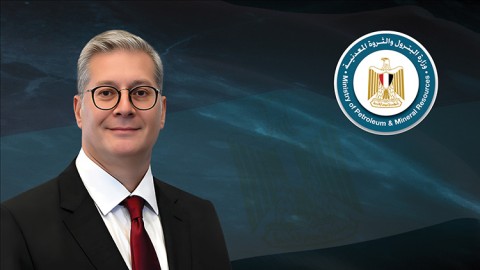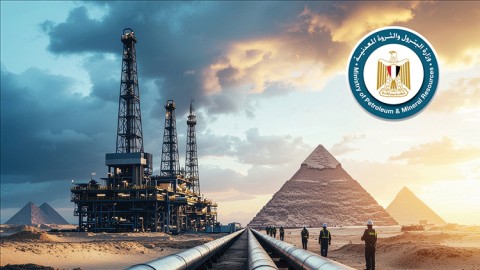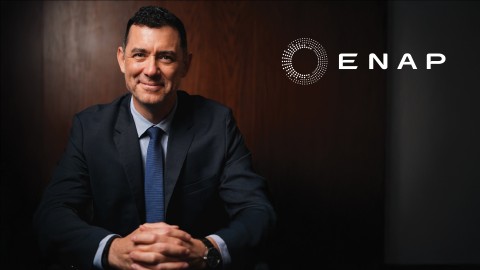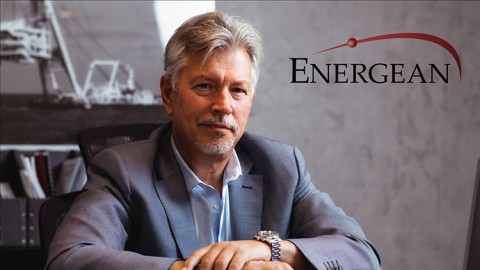Despite numerous challenges and COVID-19 impact on the oil and gas industry, Dana Gas has been able to achieve strong operational results and maintain its position regionally and internationally during 2020. Dana Gas has also been able to initiate one of Egypt’s recent significant acquisition processes. In a live interview with EOG, Dana Gas CEO Patrick Allman-Ward sheds light on Dana Gas’s strong performance and ambitious plans. He also reveals the latest details of Dana Gas’s onshore Egyptian producing oil and gas assets, while discarding all rumors of Dana Gas exiting Egypt.
How do you evaluate Dana Gas’s performance in 2020?
Given the incredible challenges that we faced in 2020, I am extremely happy with our performance. In the face of the limitations imposed by the spread of the global pandemic, we managed to maintain our production levels in both Egypt and the Kurdistan Region of Iraq (KRI) without interruptions. The global pandemic also brought with it an unprecedented collapse in the oil price; but despite this, we still managed to make an operating profit for 2020.
Firstly, our operations. When the pandemic hit our priority was the health and safety of our workforce. We put stringent health and safety protocols in place to keep our operating environments “COVID free” and we have been extremely successful in doing so.
This allowed our operations to continue uninterruptedly throughout the year. This was particularly important in the KRI, where the gas produced from our Khor Mor plant provides the feedstock for over 80% of the power generation for the region.
Despite the pandemic, we also managed to execute a debottlenecking project in the plant last July, which allowed us to further expand production by up to 50 mmscf/d. Over the past few months, we have been producing at record levels in the fourth quarter with over 440 mmscf/d; this is a 9% increase over the same quarter in 2019.
I am equally proud of our operational performance in Egypt. Here we are fighting a natural 20% decline rate from our reservoirs. We managed to limit its decline rate to 8% as a result of workover activities and production optimization measures. We have also planned an infill development well activity which will result in production increasing in 2021.
Despite the fact that oil prices fell by 34% on average over the past year and condensate prices by even more at 43%, Dana Gas still managed to make an operational profit of $36 million. This is a testimony to the Company’s operation and financial resilience.
Of course, we are helped by the fact that we are a gas company and our gas contracts are not so sensitive to oil prices, hence we have a natural hedge against low oil price environments.
We also delivered on two important strategic objectives:
– We fully redeemed the company’s $309 million outstanding Sukuk last October as well as securing a $90 million corporate facility from Mashreq and this new facility is priced at an even more attractive rate than the Sukuk
– We signed the PSA with IPR for the sale of our onshore producing assets in Egypt in October. I would be happy to elaborate upon that later.
Reflecting on 2020, did the pandemic alter your business strategy?
At the macro scale, the answer is no. We continued to execute on our long-term strategy, which is to focus on the high potential growth opportunities in our portfolio. This includes growth opportunities in the KRI and our off-shore Block 6 in Egypt. Let me provide some background and color to this.
Dana Gas entered Egypt in 2007 through the purchase of the Centurion onshore producing assets in the Nile Delta. We have been amazingly successful, drilling over 30 exploration wells with over a 60% commercial success rate. We doubled 2P reserves and increased production by over 50%.
However, we have exhausted the supply of commercially attractive drilling opportunities and the assets have become mature. The name of the game is no longer about increasing production or reserves but minimizing their reduction. This requires a huge amount of detailed management attention.
Our board decided that it would be a better use of management’s time and the Company’s resources to focus our attention on our growth opportunities in both Egypt and the KRI. To illustrate this, here are some figures: in the KRI, we have over one billion boe of 2P reserves (DG share). In Egypt, as we have not been able to replace our production over the last few years, our 2P reserves have decreased to under 60 mmboe. So we have decided to sell our onshore mature producing assets to concentrate our attention on developing the huge resource base that we have in the KRI and in exploring the huge potential of our offshore NEA Block 6 Exploration Concession Area, which we believe holds over 20 Tcf of gas and 500 mmbbls of liquids. We are gearing up to drill an exploration here in Egypt by 2023. Of course, at the level of our annual business plan, we had to make necessary and prudent adjustments.
– In light of the extraordinarily low oil prices, we had to prioritize certain projects over others and review our organizational needs. This included maintaining capital and operating costs discipline, and looking at ways to further reduce these costs.
– Due to the restrictions that were imposed by the pandemic, our contractor in the KRI declared force majeure on the implementation of the KM250 expansion project. Nonetheless, towards the end of last year, under strict COVID-19 protocols, we managed to get restarted with our civil engineering works. All being well, we should be on track to producing first gas by April 2023 and we are looking at ways to further accelerate that.
– The KM 250 is an important project for Dana Gas. It will take our total gas production capacity to nearly 700 mmScf/d. We are hoping to execute the second 250 train back-to-back with the first one, which will result in reaching nearly 1 bscf/d of production.
What measures did the company take to ensure the safety of its personnel on and off the fields during the pandemic?
As I mentioned, when the pandemic struck, our first priority was the health and safety of our staff and we moved quickly to implement stringent health and safety measures to protect all our employees. This included putting quarantine and strict testing requirements in place for our staff. Essentially, we treated our plants as if they were miniature countries in their own right.
The seamless execution of our contingency plans allowed us to keep our operations fully functional and to maintain production. In the end, all our plants have remained COVID-free.
The pandemic accelerated digitalization. How will Dana Gas further expand its use of digital solutions to optimize operations?
The oil and gas industry is a high-risk industry and so we are used to having crisis management and business continuity plans in place. In this respect, we were pretty well prepared as a business and not just ourselves. Looking back on the unprecedented dislocations that the pandemic imposed on our businesses, it is incredible that our industry continued to supply not only the energy needs of our customers but also geared up to producing the additional petrochemicals required to provide PPE to front line health care workers, disinfectants and all the other materials needed to fight this infection.
Of course, we have had to adjust our way of working to adapt to a remote working environment. And I have to say, I am amazed by how seamless this adaption has been. Whilst I know that all of our staff are looking forward to returning to a “normal” working environment, there are clearly some aspects of remote working that have been extremely beneficial to some of our staff, particularly women, and which we would like to keep on going forwards.
How did Dana Gas manage to maintain production plans amid last year’s exceptionally challenging conditions?
We took the pandemic extremely seriously from the beginning. We put strict quarantine and testing requirements in place for our staff. As I said, we essentially treated our plants as if they were miniature countries in their own right. We adjusted our work practices for longer rotations to minimize the contact that our staff might have to potential sources of infection. However, a great deal of the credit must go to our staff who showed exceptional dedication and commitment throughout the year in sticking to their duties under the most trying of circumstances. After travel restrictions were imposed in Q1 2020, some of our staff spent three to four months on location, working continuously to keep production going.
But they not only managed to keep production levels up, but they also managed to execute the debottlenecking exercise on the Khor Mor plant that allowed us to actually increase production to record levels… an amazing achievement.
Are there any updates regarding the sale of Egypt’s assets to IPR? When do you expect the deal to be finalized?
We signed the sales and purchase agreement for our onshore producing assets to IPR Energy Group in October. There are a number of activities that need to be completed in order to reach the so-called “pre-completion” milestone. This is essentially an “agreement in principle” for the sale to go ahead. The PSA allows for six months for this to take place but we are hopeful that we will get this completed this month.
Thereafter, the government needs to give its formal approval. Again, the PSA allows for six months to get this done but we are hopeful that it can take place between 60 and 90 days, meaning that the sales process will be completed by the end May.
Dana Gas has not completely left the Egyptian market and retains an offshore concession, Block 6. What are your plans for developing Block 6?
No indeed, following the sale of our onshore Egypt assets, we are not exiting from Egypt. Quite the contrary, we are focusing our attention on our amazing offshore exploration concession in North El Arish (Block 6) asset, which we are confident holds resource potential of over 20 tcf gas and 500 mmbbls of liquids. We are planning to drill the next exploration well in 2023.
Last year, we acquired 345 sq.km. of infill 3D seismic data over the top-ranking prospect in the block, which are now being interpreted and will help us chose a drilling location. On that basis, we will be able to make all the necessary preparations including finalizing the well design, which will allow us to order long-lead items that will lead to drilling the exploration well in the block in 2023.
How do you plan on maximizing the value of your assets in Egypt?
The whole basis of our company business strategy has been to focus our resources on opportunities with growth potential. The NEA Block 6 Exploration Concession is just such an asset and we are currently in the process of planning to drill a key exploration well there in 2023.
As an operator in Egypt since 2007, what makes Egypt a popular investment destination for the oil and gas industry?
This may sound odd in the context of what has happened in Egypt over the course of the last ten years. But the first observation I would make is that it is due to the track record of fiscal and contractual stability. Despite the political changes that occurred the Egyptian PSC contract remained rock-solid as was the government’s commitment to respecting those contracts.
Of course, there were difficulties, at least not around the payment of products delivered, but at no time did the government represent that the payments were not due. They simply requested flexibility of payment terms to allow the government to work through their difficulties.
As a foreign investor, well, any investor in that matter, requires respect of contract and the rule of law, to secure their investments in a stable commercial environment. Capital hates uncertainty. Investors want to know that when they put their money in, they can take the fruits of their investment out when the time comes.
Secondly, there has been amazing exploration success in the last five years in Egypt. We could reel off a list of multi-Tcf discoveries that have taken place in that period, but of course Zohr is the jewel in the crown.
What is notable about Zohr is that it has been the speed with which the field was brought on stream. This is a testament to the government’s willingness to work together with the oil companies to create an enabling environment for fast-tracking developments, and also the fiscal flexibility for negotiating a gas sales price that made the development economically viable.
I must, at this point, comment on the incredible job that H.E. Tarek El Molla, Minister of Petroleum and Mineral Resources has done over the course of the last six years. Under his leadership, the country has gone from being a net importer of gas to being a net exporter again.
Furthermore, under his leadership, the East Mediterranean Gas Forum has taken shape and promises to enable the huge gas resource potential that has been discovered over this period in the East Mediterranean to be developed and for Egypt to become the gas hub for the region. Under these circumstances, it is not surprising that Egypt has once again become a “hot exploration postcode”!
How important has Egypt been for the growth of Dana Gas?
Egypt has played a really important role in the growth of Dana Gas since beginning its operations back in 2007. As I have already mentioned when Dana Gas entered Egypt through the purchase of the Centurion onshore producing assets in the Nile Delta, we have had an amazingly successful exploration drilling program with over 30 exploration wells with over 60% commercial success rate.
We doubled 2P reserves and increased production by over 50%. Over the past 13 years, Dana Gas has grown to operate 14 Development Leases onshore the Nile Delta, all with 100% working interest and has become the fifth largest gas producer in the country. Dana Gas’s daily production in Egypt exceeds 40,000 boe/d at its peak.
How has Dana Gas supported the development of the Egyptian oil and gas industry?
Since 2007, Dana Gas has invested over $2 billion in Egypt. This has made us the country’s fifth-largest gas producer. In the process, we have created over $10 billion of value to the Egyptian economy through our gas, condensate and LPG sales. We have created significant additional value to the economy through creating job opportunities both directly and indirectly.
I am particularly proud of the sustainable development projects that our company has executed since its inception. We are conscious of our responsibilities to the communities, in which we operate. We have consistently invested over the years in those communities to improve health care, education and quality of life through supporting start-up opportunities for both men and women.
As the oil and gas industry tries to move forward from 2020, what is Dana Gas’s strategy for growth?
As I mentioned from the start, we have not been derailed by COVID. We remain steadily focused on our corporate strategy of developing our assets with material growth potential both in the KRI and in Block 6 in Egypt. This holds exciting, material upside potential, which we hope to test with an exploration well in 2023. As we enter 2021, we are in good financial health with a strong balance sheet to be able to deliver on this strategy.
In 2020, the company decided to demerge its upstream business from its midstream business. What was the reasoning behind this decision?
The demerger will allow shareholders greater flexibility to invest in their preferred company entity with different business risks and opportunities. For example, many investors may prefer the “certainty” of the Midstream business rather than the roller coaster ride of the Upstream industry as we have experienced recently.
Does Dana Gas have any other expansion plans in the near future?
We are always looking for growth opportunities and when we identify one, which we think is of an investment grade that makes sense, we will certainly participate. However, at the moment we do not have anything specific on the horizon.








